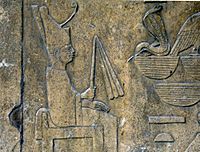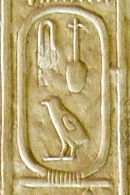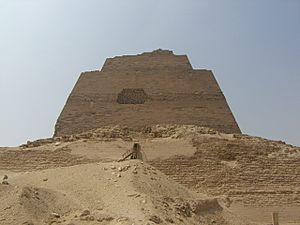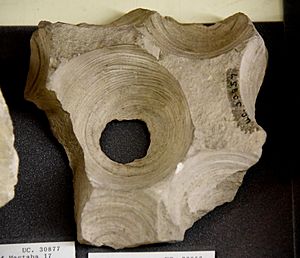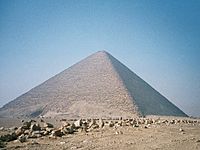Sneferu facts for kids
Quick facts for kids Sneferu |
|
|---|---|
| Snefru, Seneferu, Snofru, Soris | |

Limestone statue of Sneferu, Egyptian Museum
|
|
| Pharaoh | |
| Reign | 24, 30 or 48 years c. 2600 BC (Fourth Dynasty) |
| Predecessor | Huni |
| Successor | Khufu |
| Consort | Hetepheres I |
| Children | Khufu, Ankhhaf, Kanefer, Nefermaat, Netjeraperef, Rahotep, Ranefer, Iynefer I, Hetepheres A, Nefertkau I, Nefertnesu, Meritites I, Henutsen |
| Mother | Meresankh I |
| Burial | Red Pyramid (possibly) |
| Monuments | Meidum Pyramid, Bent Pyramid, Red Pyramid |
Sneferu (also spelled Snefru or Snofru), known as Soris in ancient Greek, was a powerful pharaoh of Ancient Egypt. He was the founder of the Fourth Dynasty of Egypt during the Old Kingdom. Historians believe he ruled for a long time, possibly over 30 years, starting around 2613 BC. During his reign, Sneferu built at least three large pyramids. He also introduced new and important ideas for how pyramids were designed and built.
Contents
How Long Did Sneferu Rule?
It's tricky to know exactly how long ancient pharaohs ruled. For Sneferu, records like the Turin King List suggest he ruled for 24 years. However, other ancient writings, like the Palermo Stone, mention events from later years of his reign. These records talk about "cattle counts," which were like a census or tax collection that happened regularly.
Because of these records, experts now think Sneferu ruled for at least 27 years. Some even believe his reign was over 30 years long. This long rule would have given him enough time to plan and build his three huge pyramids.
Sneferu's Family and Successors
Sneferu was the first king of the Fourth Dynasty of Egypt. An ancient Egyptian priest named Manetho grouped pharaohs into dynasties, and we still use his system today. Before Sneferu, King Huni was the ruler. An old text called the Papyrus Prisse says that when Huni died, Sneferu became king. This text also describes Sneferu as a "beneficent king," meaning he was seen as a good ruler. His name, Sneferu, can even mean "to make beautiful."
Sneferu's main wife was Hetepheres I. She was the mother of Khufu, who later built the famous Great Pyramid at Giza.
Sneferu's Children
Sneferu had many children. Here are some of his sons:
- Khufu – He was the son of Sneferu and Queen Hetepheres I. Khufu became king after his father.
- Ankhhaf – He was a "King's Son" and later a vizier (a high-ranking official). A famous statue of him is in a museum in Boston.
- Kanefer – He was Sneferu's oldest son and also served as a vizier.
- Nefermaat I – Another eldest son, he was a priest and Sneferu's first vizier.
- Rahotep – He was a high priest of the sun god Ra. His famous statues are in the Cairo Museum.
Here are some of Sneferu's daughters:
- Hetepheres A – She was named after her mother, Queen Hetepheres.
- Nefertkau I – She was Sneferu's oldest daughter.
- Meritites I – She married her brother, Khufu.
- Henutsen – She also married Khufu.
Sneferu's Amazing Building Projects
Sneferu is most famous for the three massive pyramids he built. These are the Bent Pyramid and the Red Pyramid in Dahshur, and the Meidum pyramid. Under Sneferu, pyramid building changed a lot. These changes led to the building of Khufu's Great Pyramid, which is one of the most amazing structures of the ancient world.
The Meidum Pyramid
The Meidum Pyramid was Sneferu's first huge project. Some experts think it might have been started by King Huni, but Sneferu definitely finished it. This pyramid shows how pyramid building changed from "stepped" pyramids (like a giant staircase) to "true" pyramids with smooth, angled sides.
Archaeologists found that the Meidum pyramid was first planned with seven steps. Then, another step was added. Finally, smooth limestone was put on the outside to make it look like a true pyramid. Inside, it had a passage going down, two underground rooms, and a burial chamber. What was new is that the burial chamber was built inside the main pyramid structure, not just underneath it.
The Bent Pyramid
The Bent Pyramid, also called the Rhomboidal or Blunted Pyramid, shows even more new ideas in building. Its name comes from its shape: the angle of its sides changes partway up, from 55 degrees to about 43 degrees. This change likely happened during construction because the ground or the lower layers of the pyramid were not stable. To make it stronger, the top layers were laid flat, moving away from the old step pyramid style.
The inside of the Bent Pyramid also had new features. It has two entrances, one on the north and one on the west. The underground rooms are much bigger and have special ceilings and complex systems to block passages.
In July 2019, Egypt opened the Bent Pyramid to tourists for the first time since 1965. Visitors can now go into two 4,600-year-old rooms through a narrow tunnel. A smaller pyramid next to it, thought to be for Sneferu's wife Hetepheres, also opened to the public.
The Red Pyramid
The Red Pyramid was Sneferu's last and largest pyramid. It gets its name from the reddish stone used to build it. While it looks simpler from the outside than the Bent Pyramid, it was still a huge achievement.
Some of the advanced internal features of the earlier pyramids seem to be missing here. However, some archaeologists believe there might be secret rooms inside that haven't been found yet. Since Sneferu's mummy has never been found, it's possible his burial chamber is still hidden within this mysterious pyramid.
Sneferu's new ideas in pyramid building were very important. They set a high standard for future kings. Only his son Khufu's Great Pyramid could truly compare to Sneferu's achievements. Over time, as Egyptian beliefs changed, the pyramids built by later kings became much smaller.
Foreign Relations and Resources
To build such huge pyramids, Sneferu needed a lot of workers and materials. This is where his foreign policy came in. Sneferu led military trips into lands like Libya and Nubia. These trips had two main goals:
- To capture people who could work on his building projects.
- To get important raw materials and special goods from these countries.
The Palermo Stone, an ancient record, mentions some of these activities:
- It talks about building many ships from special wood.
- It describes a raid into "the Land of the Blacks" (Nubia), where 7,000 prisoners and 20,000 cattle, sheep, and goats were captured.
- It also mentions bringing in 40 ships full of cedar wood, likely from Lebanon.
These trips helped Sneferu get the large workforce and resources he needed. They also provided food for his many workers. Sneferu's military actions in Libya led to the capture of 11,000 prisoners and 13,100 cattle. He also got turquoise from mines in the Sinai Peninsula. All these resources were essential for his massive pyramid projects.
Sneferu even had a famous cedar wood ship named "Praise of the Two Lands." This is the first time we know of a ship being given a specific name.
See also
 In Spanish: Seneferu para niños
In Spanish: Seneferu para niños
- List of Egyptian pyramids
- List of megalithic sites
- 4906 Seneferu, a minor planet named for the pharaoh


